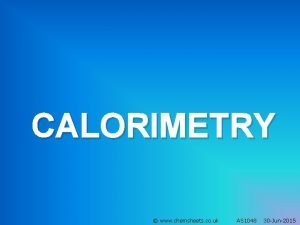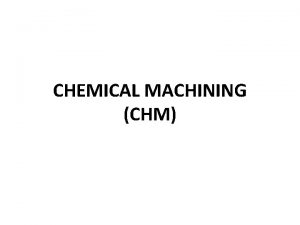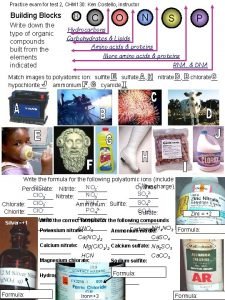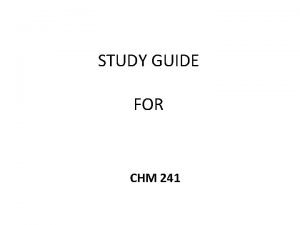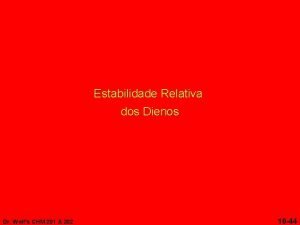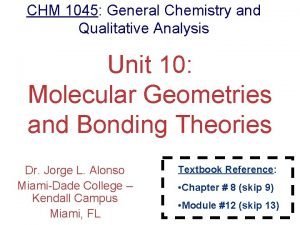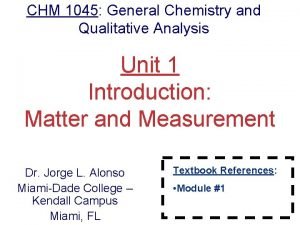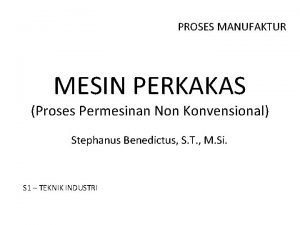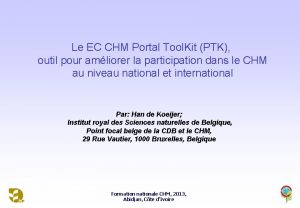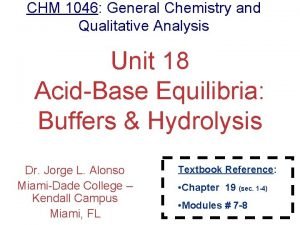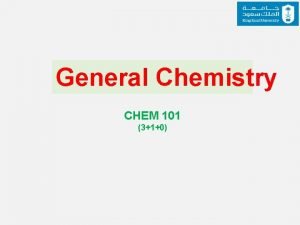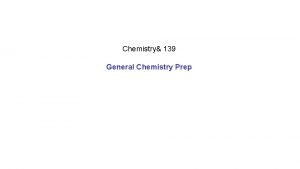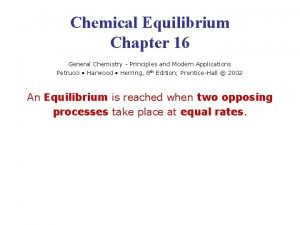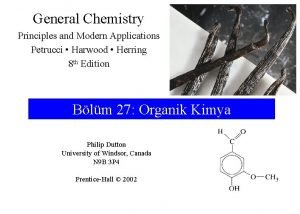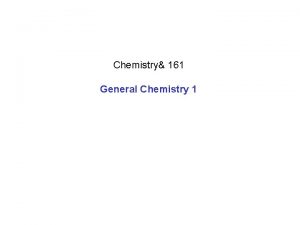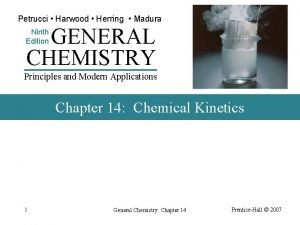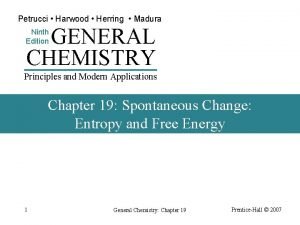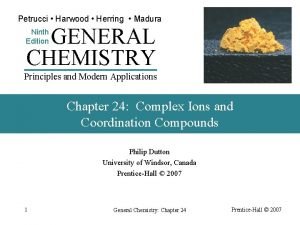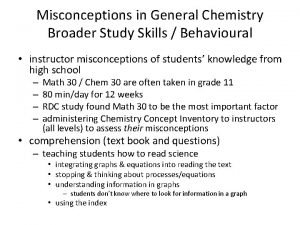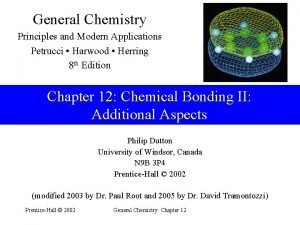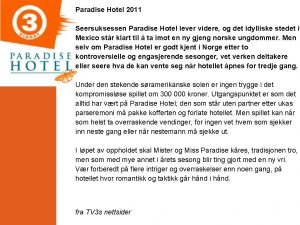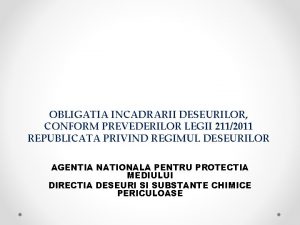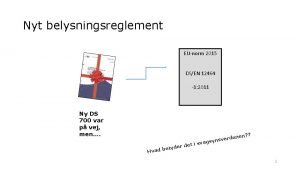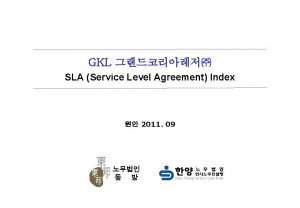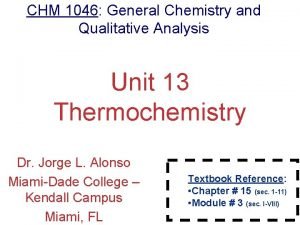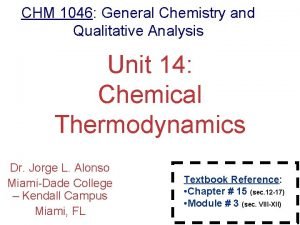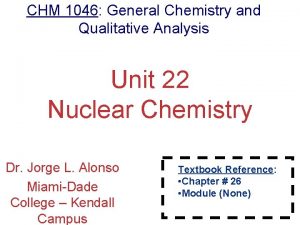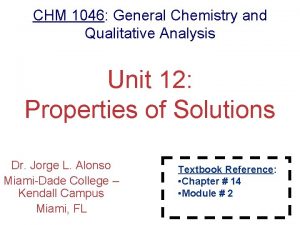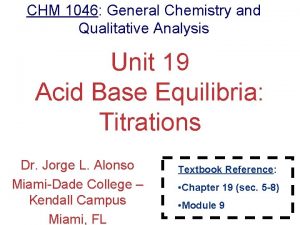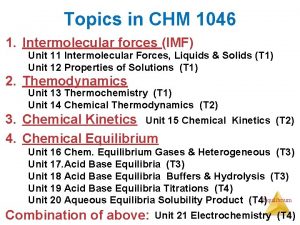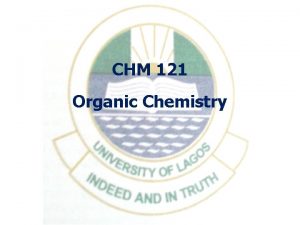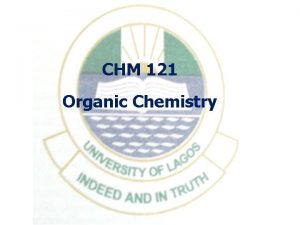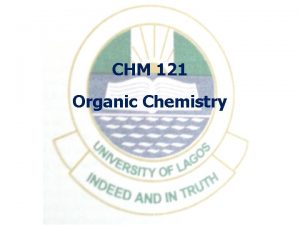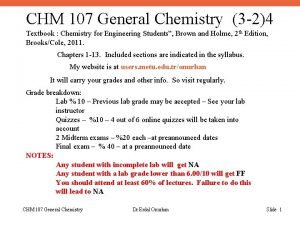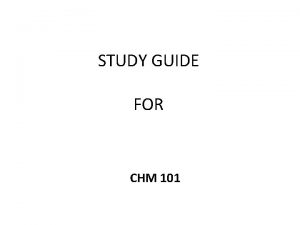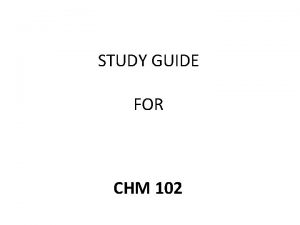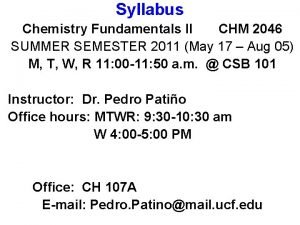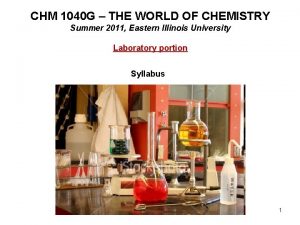CHM 1046 General Chemistry 2 Summer A 2011



























































- Slides: 59

CHM 1046 - General Chemistry 2 Summer A 2011 Dr. Jeff Joens Classroom: CP 145 Time: M, T, W, R 11: 00 am to 12: 15 pm Office: CP 331 phone 348 -3121 web page: www. joenschem. com email: joensj@fiu. edu

Homework Problems Chapter 12 Homework Problems: 2, 5, 8, 12, 20, 23, 32, 34, 36, 42, 52, 64, 72, 74, 78, 80, 84, 89, 98 Note: Homework is not to be turned in. My solutions to the homework problems are available at my website. Answers (but not detailed solutions) to the in chapter practice problems and the odd numbered end of chapter problems are given at the end of the book. There also several copies of the solution manual (Solutions Manual for Chemistry: A Molecular Approach) available at the Reserve Desk (2 nd Floor of the Green Library) under Dr. Graves name. This solution manual gives detailed solutions to all of the problems in the book.

CHAPTER 12 Solutions

Solutions A solution is a homogeneous mixture. The major component of a solution is called the solvent, while the minor components are called solutes. There are several common kinds of solutions kind of solution example gas in gas air (78% N 2, 21 % O 2, 0. 9 % Ar + others) gas in liquid O 2 in water liquid in liquid ethanol in water solid in liquid Na. Cl in water solid in solid alloys (bronze - copper + tin) We will usually focus on solutions where the solvent is a liquid, but all of the above combinations represent possible types of solutions.

Solubility The term solubility means the amount of a particular solute that will dissolve in a given amount of solvent (usually a liquid). There are two common ways in which solubility is given. 1) Mass solute per mass solvent. Indicates the maximum mass of solute that will dissolve in a given mass of solvent. Example: At 25 C the solubility of sodium chloride in water is 36. g Na. Cl per 100. g water. 2) Molar solubility. The maximum number of moles of solute per liter of solution. Example: The molar solubility of silver chloride (Ag. Cl) in pure water at 25 C is 1. 3 x 10 -5 mol/L. (Equivalent to 1. 9 x 10 -4 g per 100 g water). There are other ways of expressing solubility, including mass per volume of solvent, and solubility product.

Soluble and Insoluble There are several common terms that refer to the ability of a solid solute to dissolve in a liquid solvent. Soluble - Indicates that a large amount of solute will dissolve in a given amount of solvent. Insoluble - Indicates that a small amount, or no, solute will dissolve in a given amount of solvent. In our above examples sodium chloride is soluble in water and silver chloride is insoluble in water. In fact, many substances classified as “insoluble” will dissolve to a small extent in water or other solvents. We will discuss this in more detail later in the semester.

Miscible and Immiscible Liquids We can classify liquids in terms of their ability to form solutions when mixed. Two liquids are miscible if any amounts of the two liquids will combine to form a solution (water + ethyl alcohol). Two liquids are immiscible if they do not mix (water + gasoline).

Thermodynamics of Solution Formation Consider the following general process for the formation of a solution by dissolving a liquid or solid solute in a liquid solvent. M(s) M(soln) There are two factors that favor formation of a solution: 1) An increase in the randomness of the system. 2) A decrease in the energy of the system. For now, we will take energy (E) and enthalpy (H) as meaning the same thing, as they are usually close in value.

Entropy of Solution ( Ssoln) 1) An increase in the randomness or disorder of the system. In thermodynamics randomness is measured in terms of entropy. For solutions the change in entropy is called Ssoln. Consider the dissolution of a solid in a liquid. We would expect that the solution is less ordered than the starting pure solid and pure liquid. Therefore, we expect Ssoln > 0 (surprisingly, there a few cases where Ssoln < 0, but they are extremely rare).

Enthalpy of Solution ( Hsoln) 2) A decrease in the energy of the system. If mixing lowers the energy of a system then it is more likely to occur. Since solutions are usually prepared under conditions of constant pressure, we look at the enthalpy of solution, Hsoln, defined as the change in enthalpy for the process M(s) M(soln) Hsoln To decide whether Hsoln will be positive, negative, or approximately zero we need to consider three type of attractive forces. solvent-solvent - Attractive forces acting between solvent molecules. solute-solute - Attractive forces acting between solute molecules. solvent-solute - Attractive forces acting between a solvent molecule and a solute molecule.

Steps In Solution Formation We can think solution formation as a three step process: 1) Separate the solute particles Hsolute > 0 2) Separate the solvent particles Hsolvent > 0 3) Mix solute and solvent particles Hmixing < 0 ______________________ Formation of solution Hsolution From Hess’ law Hsolution = Hsolute + Hsolvent + Hmixing

Examples of Solvent-Solute Attractive Forces

Hsoln For Various Solvent + Solute Combinations solvent polar nonpolar solute polar nonpolar solvent-solvent attraction strong weak solute-solute attraction strong weak solvent-solute attraction strong weak enthalpy change ( Hsoln) ~0 positive ~0

Solution Formation Hsoln Ssoln Will a solution form? negative positive Yes. ~ zero positive Yes. positive Maybe. A general consequence of the above is the general rule in mixing liquids that “like dissolves like”. Two polar liquids or two nonpolar liquids will usually mix (because Hsoln 0), but a polar and a nonpolar liquid will not usually mix (because Hsoln >> 0).

Solutions of Ionic Compounds in Water For solutions of ionic compounds in water we may use Hess’ law to understand the factors involved in the change in energy for solution formation. The change in energy for solution formation, Hsoln, is Hsoln = | Hlattice| - | Hhydration|

Example - KF(s) in water Since | Hlattice| | Hhydration|, then Hsoln 0. (Actually endothermic by ~ 2 k. J/mol).

Classification of Solutions can be classified according to the relative amount of dissolved solute. Unsaturated solution - Contains less than the maximum equilibrium amount of dissolved solute. Saturated solution - Contains the maximum equilibrium amount of dissolved solute. Supersaturated solution - Contains more than the maximum equilibrium amount of dissolved solute. Note that a supersaturated solution is unstable. It will spontaneously form a precipitate until it becomes a saturated solution.

Effect of Temperature On Solubility Note that the solubility of most solids in water or other liquids increases with increasing temperature.

Recrystallization The increase in the solubility of a solid in a liquid solvent is the basis of a purification technique called recrystallization. The solid is dissolved in a minimum amount of hot solvent. When the solvent cools, the solute precipitates to form pure crystals.

Gas Solubility Gases can also dissolve in liquids. Gas solubility is described by Henry’s law [A] = k. H p. A [A] = concentration of dissolved A (in mol/L) p. A = partial pressure of A above the solution k. H = Henry’s law constant The value for the Henry’s law constant depends on the solvent, the gas, and temperature. For most gases solubility is low (exceptions are gases that can chemically interact with the solvent) and solubility decreases as temperature increases.

Example: The Henry’s law constant for water is k. H = 2. 02 x 10 -3 mol/L. atm at T = 20 C. What is the concentration of dissolved oxygen in water in equilibrium with the Earth’s atmosphere (p. O 2 = 0. 21 atm)?

Example: The Henry’s law constant for water is k. H = 2. 02 x 10 -3 mol/L. atm at T = 20 C. What is the concentration of dissolved oxygen in water in equilibrium with the Earth’s atmosphere (p. O 2 = 0. 21 atm)? [O 2] = k. H p. O 2 = (2. 02 x 10 -3 mol/L. atm) (0. 21 atm) = 4. 2 x 10 -4 mol/L (or 0. 0135 g/L) While small, this is enough dissolved oxygen to support fish life.

Concentration Units - Molarity There are several common units for solutions. Molarity (M) = moles solute liters solution Molarity is the most common concentration unit used for solutions because it is easy to prepare solutions with know values of molarity. Note that molarity depends on temperature, because the volume occupied by a solution changes when temperature changes.

Concentration Units - Molality and Mole Fraction Solution concentrations can also be given in terms of molality and mole fraction. Molality (m) = moles solute kg solvent Mole fraction (Xi) = ntotal ni = moles of ith substance total number of moles Molality and mole fraction are used in some specialized applications, such as in equations for some of the colligative properties of solutions and in Dalton’s law of partial pressure. Note that molality and mole fraction are temperature independent.

Concentration Units - Percent By Mass, Parts By Mass or Volume, and Related Units We can also give solution concentrations in terms of the masses of substances present in the solution. Percent by mass (mass %) = mass of solute x 100 % mass of solution Parts per million by mass (ppm) = mass of solute x 106 mass of solution Parts per million by volume (ppm) = volume of solute x 106 volume of solution By analogy with ppm (parts per million) we can also define ppb (parts per billion; multiply by 109) or parts per trillion (ppt; multiply by 1012). We always should indicate if parts per… is by mass or by volume. We can also define percent by volume, or mole percent (percent by moles).

Solution Calculations There are two general types of problems you should be able to do in connection with solutions. 1) Given information on how a solution is prepared, you should be able to find the solute concentration (molarity, molality, mole fraction, mass percent, and so forth). 2) Conversion from one concentration unit to a different concentration unit. Example: A solution is prepared by mixing 40. 00 g ethylene glycol (C 2 H 6 O 2, M = 62. 07 g/mol) and 60. 00 g water (H 2 O, M = 18. 02 g/mol). The density of the solution is D = 1. 0514 g/m. L. What are the molarity, molality, mole fraction, and percent by mass ethylene glycol in the solution?

Example: A solution is prepared by mixing 40. 00 g ethylene glycol (C 2 H 6 O 2, MW = 62. 07 g/mol) and 60. 00 g water (H 2 O. MW = 18. 02 g/mol). The density of the solution is D = 1. 0514 g/m. L. What are the molarity, molality, mole fraction, and percent by mass ethylene glycol in the solution? n. E = 40. 00 g 1 mol = 0. 6444 mol E 62. 07 g n. W = 60. 00 g 1 mol = 3. 3296 mol W 18. 02 g XE = n. E + n. W = (0. 6444 mol) = 0. 1622 (0. 6444 + 3. 3296)mol m. E = mol E = 0. 6444 mol = 10. 74 mol/kg kg H 2 O 0. 06000 kg

The total mass of solution is m = 40. 00 g + 60. 00 g = 100. 00 g. Since the density of the solution is D = 1. 0514 g/m. L, the volume of the solution is V = 100. 00 g 1 m. L = 95. 11 m. L 1. 0514 g So ME = 0. 6444 mol = 6. 775 mol/L 0. 09511 L Finally, the mass percent ethylene glycol is mass % = m. E + m W . 100 % = 40. 00 % 40. 00 g (40. 00 + 60. 00)g

Volatile Liquids and Vapor Pressure A volatile liquid is a liquid that has a significant vapor pressure. A volatile liquid will, if left exposed in the atmosphere, evaporate. Liquids that do not have a significant vapor pressure are called nonvolatile. Vapor pressure is defined as the equilibrium pressure of gas above a sample of pure liquid. The value for the vapor pressure depends on temperature, and increases when temperature increases.

Solutions of Volatile Liquids - Raoult’s Law Raoult’s law is a relationship that applies to some solutions of volatile liquids. Consider a solution consisting of two volatile liquids A and B. Raoult’s law predicts that the partial pressure of vapor from each liquid above the solution is given by the relationships p. A = XA p. A p. B = XB p. B where pare pthe partial AB, pressures of A and B above the solution XA, XB are the mole fraction of A and B in the solution p. A , p. B are the vapor pressures of pure A and pure B

Example: At 20 C the vapor pressure of pure benzene is 24. torr and the vapor pressure of pure toluene is 76. torr. Consider a solution with XB = 0. 40. Assuming that benzene and toluene form an ideal solution, find the partial pressure of benzene and toluene and the total pressure above the solution.

Example: At 20 C the vapor pressure of pure benzene (B) is 24. torr and the vapor pressure of pure toluene (T) is 76. torr. Consider a solution with XB = 0. 40. Assuming that benzene and toluene form an ideal solution, find the partial pressure of benzene and toluene and the total pressure above the solution. From Raoult’s law, p. A = XAp. A XB + XT = 1, so XT = 1 – XB = 1 – 0. 40 = 0. 60 So p. B = (0. 40)(24. torr) = 9. 6 torr p. T = (0. 60)(76. torr) = 45. 6 torr ptotal = psoln = p. B + p. T = 9. 6 torr + 45. 6 torr = 55. 2 torr

Ideal Solution An ideal solution is a solution whose components obey Raoult’s law. The solvent in a solution will always obey Raoult’s law in the limit XA 1. In a mixture of two liquids A and B there are three types of intermolecular forces A --- A molecules of A with A B --- B molecules of B with B A --- B molecules of A with B Solutions will generally be close to ideal if they are composed of similar molecules with similar intermolecular attractive forces (so usually molecules that are both nonpolar).

Ideal and Nonideal Solution For an ideal solution a plot of pressure vs mole fraction will be linear. If such a plot is not linear, then we have a nonideal solution. A = C 6 H 6; B = C 6 H 5 CH 3 A = CH 3 COCH 3; B = CS 2 Note that since XA + XB = 1, XB = 1 - XA.

Solutions With a Nonvolative Ionic Solute For a solution containing a nonvolatile ionic solute (or any nonvolatile solute that can dissociate into smaller particles) there is one additional complicating factor. As before, there will only be solvent molecules above the solution. If the solvent obeys Raoult’s law (true if dilute solution), then p. A = psoln = XA p. A However, we must take into account the ionization or dissociation of the solute in calculating the mole fraction of solvent. XA = moles of solvent particles total moles of particles XB = moles of solute particles total moles of particles

Finding the Moles of Particles (Examples) Consider the following three substances: C 6 H 12 O 6 (sugar) Na. Cl (sodium chloride) K 2 SO 4 (potassium sulfate) When the above substances are dissolved in water how many moles of particles will form per mole of dissolved substance?

Finding the Moles of Particles (Examples) C 6 H 12 O 6 (sugar) C 6 H 12 O 6(s) C 6 H 12 O 6(aq) mol particles = 1. 00 mole sugar 1 mole particle = 1. 00 mol particles 1 mol sugar Na. Cl (sodium chloride) Na. Cl(s) Na+(aq) + Cl-(aq) mol particles = 1. 00 mol Na. Cl 2 mol particles = 2. 00 mol particles 1 mol Na. Cl K 2 SO 4 (potassium sulfate) K 2 SO 4(s) 2 K+(aq) + SO 42 -(aq) mol particles = 1. 00 mol K 2 SO 4 3 mol particles = 3. 00 mol particles 1 mol K 2 SO 4

Van’t Hoff Factor (i) The van’t Hoff factor, i, is defined as i= moles of particles moles of solute So moles of particles = i (moles of solute) For the above examples: C 6 H 12 O 6(s) C 6 H 12 O 6(aq) i=1 Na. Cl(s) Na+(aq) + Cl-(aq) i=2 K 2 SO 4(s) 2 K+(aq) + SO 42 -(aq) i=3

Experimental Values for the. Van’t Hoff Factor The value for the van't Hoff factor can be found experimentally. For dilute solutions the experimental value for the van’t Hoff factor is close to the value predicted from theory. However, for more concentrated solutions the experimental value is lower than that expected. For example, for Na. Cl(s) Na+(aq) + Cl-(aq) Molality Na. Cl itheory iexperimental 0. 0001 2. 0 1. 99 0. 001 2. 0 1. 97 0. 01 2. 0 1. 94 0. 1 2. 0 1. 87 Unless otherwise stated we will use theoretical value for i.

Example The vapor pressure of pure water is p. W = 149. 4 torr at T = 60. C. Find the partial pressure of water above each of the following solutions at T = 60. C. You may assume the solvent (water) behaves ideally. a) 1. 00 mol sugar (C 6 H 12 O 6) and 1000. g water. b) 1. 00 mol calcium nitrate (Ca(NO 3)2) and 1000. g water.

The vapor pressure of pure water is p. W = 149. 4 torr at T = 60. C. Find the partial pressure of water above each of the following solutions at T = 60. C. a) 1. 00 mol sugar (C 6 H 12 O 6) and 1000. g water. moles water = 1000. g water 1 mol water = 55. 56 mol 18. 0 g water moles solute particles (sugar) = 1. 00 mol (i = 1) XW = 55. 56 mol = 0. 982 (55. 56 + 1. 00)mol p. W = (0. 982) (149. 4 torr) = 146. 7 torr

The vapor pressure of pure water is p. W = 149. 4 torr at T = 60. C. Find the partial pressure of water above each of the following solutions at T = 60. C. b) 1. 00 mol calcium nitrate (Ca(NO 3)2) and 1000. g water. moles water = 1000. g water 1 mol water = 55. 56 mol 18. 0 g water Ca(NO 3)2(s) Ca 2+(aq) + 2 NO 3 -(aq) (i = 3) moles solute particles (Ca(NO 3)2) = 1. 00 mol Ca(NO 3)2 3 mol particle 1 mol Ca(NO 3)2 XW = 55. 56 mol = 0. 949 (55. 56 + 3. 00)mol p. W = (0. 949) (149. 4 torr) = 141. 8 torr = 3 mol particles

Colligative Property A colligative property is any property of a solution consisting of a volatile solvent and a nonvolatile solute that depends at most on two things: 1) The physical properties of the solvent 2) The number or concentration of solute particles There are four colligative properties - vapor pressure lowering - boiling point elevation - freezing point depression - osmotic pressure The equations given for colligative properties apply to ideal conditions and are therefore expected to be correct in the limit Xsolvent 1.

Vapor Pressure Lowering Consider the situation below. The left side contains pure solvent A, while the right side contains a solution of A and a nonvolatile solute. pleft = p. A pright = XA p. A We may define the vapor pressure lowering p = pleft - pright, and so p = p. A - XA p. A = (1 - XA) p. A But XA + XB = 1, so 1 - XA = XB, and so p = XB p. A , the final expression for vapor pressure lowering.

Measurement of Vapor Pressure Lowering The apparatus shown below can be used to accurately measure the vapor pressure of a solution relative to that of a pure liquid. Note that the working fluid in the manometer is often chosen to be a non-volatile liquid of lower density than mercury, such as sulfuric acid or mineral oil.

Boiling Point Elevation and Freezing Point Depression Consider the situation below. The left side contains pure solvent A, while the right side contains a solution of A and a nonvolatile solute. The boiling point of the solution will be higher than the boiling point of the pure liquid, and the freezing point of the solution will be lower than the freezing point of the pure liquid. Tb = Tb - Tb° = Kb m. B boiling point elevation Tf = Tf° - Tf = Kf m. B freezing point depression Kb, Kf = boiling point elevation and freezing point depression constants Tb, Tf = boiling and freezing point for the solution Tb°, Tf ° = boiling and freezing point for the pure liquid m. B = molality of solute particles

Example A solution is prepared by dissolving 1. 00 mol sodium chloride (Na. Cl) in 1000. g of water. What are the normal freezing point and normal boiling point for this solution. Tb = 100. 00 C Tf = 0. 00 C Kb = 0. 512 C/m Kf = 1. 86 C/m

A solution is prepared by dissolving 1. 00 mol sodium chloride (Na. Cl) in 1000. g of water. What are the normal freezing point and normal boiling point for this solution. Na. Cl(s) Na+(aq) + Cl-(aq) (i = 2) Tb = 100. 00 C Tf = 0. 00 C Kb = 0. 512 C/m Kf = 1. 86 C/m molality Na. Cl = 1. 00 mol Na. Cl 2 mol particles = 2. 00 mol particles 1. 000 kg water 1 mol Na. Cl kg water So Tb = (0. 512 C/m) (2. 00 m) = 1. 02 C Tf = (1. 86 C/m) (2. 00 m) = 3. 72 C Tb = 100. 00 C + 1. 02 C = 101. 02 C Tf = 0. 00 C - 3. 72 C = - 3. 72 C

Phase Diagram For Solutions We can picture the differences between the behavior of a pure liquid and a solution of the liquid and a nonvolative solute in terms of the corresponding phase diagram. In a sense all that has changed for the solution is the location of the triple point, which affects the locations of the phase boundaries, as indicated in the phase diagram at right.

Osmotic Pressure Consider the apparatus below. The right chamber contains a pure liquid, while the left chamber contains a solution of the liquid and a nonvolatile solute. The two chambers are separated by a semipermeable membrane that allows solvent molecules to pass but prevents the passage of solute molecules. The osmotic pressure, , is defined as the additional pressure that must be applied to the solution to keep the level of liquid in both chambers the same.

Semipermeable Membrane A semipermeable membrane is a barrier that allows some particles to pass through but which prevents the passage of other particles. The discrimination is usually based on the size of the particles (or, for ions, the size of the hydrated or solvated ions).

Calculation of Osmotic Pressure For dilute solutions the osmotic pressure is given by the relationship = [B]RT , where [B] is the molarity of solute particles (mol/L) Example: What is the osmotic pressure for a 0. 0100 M solution of sugar (C 6 H 12 O 6) and a 0. 0100 M solution of sodium chloride (Na. Cl) in water at T = 25. C? Recall that Na. Cl(s) Na+(aq) + Cl-(aq) gives two solute particles for every formula unit of Na. Cl (i = 2).

Example: What is the osmotic pressure for a 0. 0100 M solution of sugar (C 6 H 12 O 6) and a 0. 0100 M solution of sodium chloride (Na. Cl) in water at T = 25. C? Recall that Na. Cl(s) Na+(aq) + Cl-(aq) gives two solute particles for every formula unit of Na. Cl (i = 2). = [B]RT , where [B] molarity of solute particles (mol/L) For sugar [B] = 0. 0100 M. For Na. Cl, [B] = 0. 0200 M (sugar) = (0. 0100 mol/L)(0. 08206 L. atm/mol. K)(298 K) = 0. 245 atm ( = 186. Torr) (Na. Cl) = (0. 0200 mol/L)(0. 08206 L. atm/mol. K)(298 K) = 0. 489 atm ( = 372. Torr)

Applications to Molecular Mass Determination Any of the four colligative properties may be used to determine the molecular mass of a nonvolative solute. In practice osmotic pressure or vapor pressure lowering are usually used, as they are more sensitive and can be used to find the molecular mass of high molecular mass molecules. Example: A solution is prepared by dissolving 0. 1438 g of a nonvolatile and nonionizing solute in water to form a solution of final volume V = 25. 00 m. L. The osmotic pressure of the solution, measured at T = 37. 0 C, is 21. 6 torr. What is the molecular mass of the solute?

Example: A solution is prepared by dissolving 0. 1438 g of a nonvolatile and nonionizing solute in water to form a solution of final volume V = 25. 00 m. L. The osmotic pressure of the solution, measured at T = 37. 0 C, is 21. 6 torr. What is the molecular mass of the solute? MW = m/n = grams/moles = [B]RT = 21. 6 torr (1 atm/760 torr) = 0. 02842 atm [B] = = 0. 02842 atm = 1. 117 x 10 -3 mol/L RT (0. 08206 L. atm/mol. K) (310. K) n = (0. 02500 L) (1. 117 x 10 -3 mol/L) = 2. 792 x 10 -5 mol M= 0. 1438 g 2. 792 x 10 -5 mol = 5150. g/mol

Reverse Osmosis One interesting application of a colligative property is the use of reverse osmosis to purify seawater. The high pressure forces water through the semipermeable membrane while trapping ions and larger molecules. The process is usually more expensive than other sources of potable water, but can be economically viable in some cases.

Medical Applications of Osmotic Pressure The membranes of red blood cells are semipermeable membranes. Therefore, these cells can experience an osmotic pressure when placed in a liquid with a different molality than blood plasma, which has a molality m 0. 30 mol/kg, about the same molality as a 0. 9 g Na. Cl per 100. g water solution. isotonic - same molality as blood plasma hypertonic - higher molality than blood plasma (crenation) hypotonic - lower molality than blood plasma (hemolysis)

Colloid A colloid is a mixture of small particles suspended within a substance. The particles in a colloid are larger than the solute molecules or ions in a solution. The size of colloid particles is generally in the range 1 - 1000 nm.

End of Chapter 12 “If you're not part of the solution, you're part of the precipitate. ” - unknown “How can you distinguish science from junk? Science posits hypothesis and tests them. Pseudoscience assumes conclusions and finds evidence to back them up. ” - Wendy Kaminer, Sleeping With Extra. Terrestrials
 Chemsheets a2 1048 answers
Chemsheets a2 1048 answers Chemistry 151 final exam
Chemistry 151 final exam Chemistry
Chemistry Etch factor in chemical machining
Etch factor in chemical machining Chem 130 final exam
Chem 130 final exam Chm 241
Chm 241 Chm 201
Chm 201 Chm 1045
Chm 1045 Chm 111
Chm 111 Mesin non konvensional
Mesin non konvensional Chm tool
Chm tool Chm logo
Chm logo Chemistry regents 2011
Chemistry regents 2011 Honors chemistry summer assignment
Honors chemistry summer assignment Functional groups ib chemistry
Functional groups ib chemistry Inorganic vs organic chemistry
Inorganic vs organic chemistry General chemistry with qualitative analysis
General chemistry with qualitative analysis General chemistry thermochemistry
General chemistry thermochemistry General chemistry nomenclature
General chemistry nomenclature General chemistry 2
General chemistry 2 General chemistry ders notları
General chemistry ders notları General chemistry
General chemistry General chemistry 1 stoichiometry
General chemistry 1 stoichiometry General chemistry
General chemistry General chemistry
General chemistry Exchange energy
Exchange energy General chemistry
General chemistry General chemistry
General chemistry Planos en cinematografia
Planos en cinematografia Where did general lee surrender to general grant?
Where did general lee surrender to general grant? Wyd 2011 madrid
Wyd 2011 madrid Small business server 2010
Small business server 2010 Small business server 2011 end of life
Small business server 2011 end of life Three typical goal of communication as stipulated by seitel
Three typical goal of communication as stipulated by seitel Uma equipe de cientistas lançará
Uma equipe de cientistas lançará Per-30/pb/2011
Per-30/pb/2011 Yevarejeja yahweh
Yevarejeja yahweh Dorothea puente
Dorothea puente Sage act 2011
Sage act 2011 2011-1989
2011-1989 Boardworks ltd 2011
Boardworks ltd 2011 Perfil de egreso de primaria
Perfil de egreso de primaria Pergub 140 tahun 2011
Pergub 140 tahun 2011 Contoh penilaian prestasi kerja
Contoh penilaian prestasi kerja Usa infotehnoloog 1955-2011
Usa infotehnoloog 1955-2011 Akta perundingan gaji negara 2011
Akta perundingan gaji negara 2011 Paradise hotel 2011 deltakere
Paradise hotel 2011 deltakere Legea 211 2011
Legea 211 2011 En 12464-1:2011
En 12464-1:2011 National population and housing census 2011
National population and housing census 2011 Eecs 2011
Eecs 2011 Unieważnienie matury 2011
Unieważnienie matury 2011 Lloyds open form
Lloyds open form Windows movie maker 2011
Windows movie maker 2011 Maker
Maker Ebm hierarchy
Ebm hierarchy Hpec 2011
Hpec 2011 Firebase 2011
Firebase 2011 Sla 2011
Sla 2011 Federal court rules 2011
Federal court rules 2011
